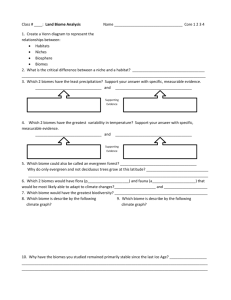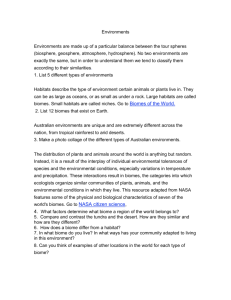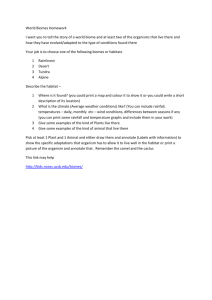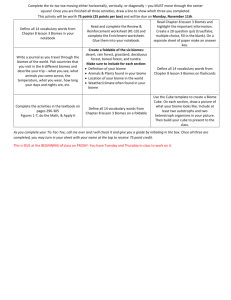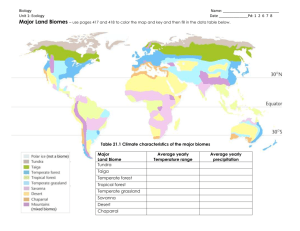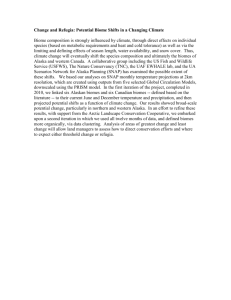Ecosystems & Biomes A biome is defined as the similar ecosystems
advertisement
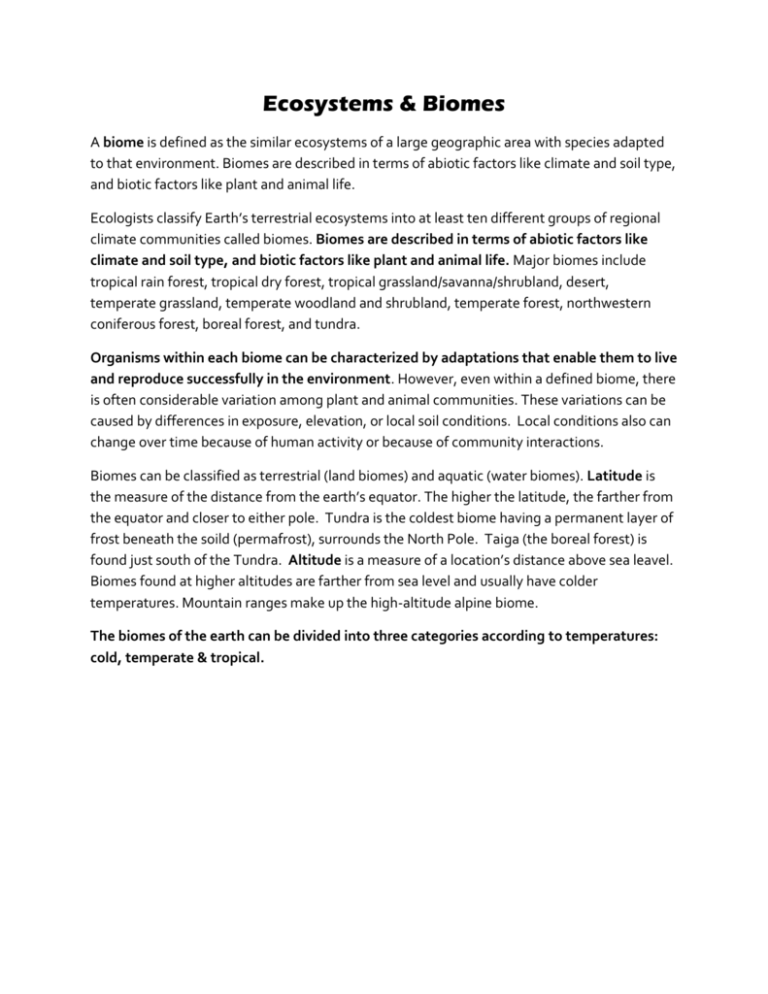
Ecosystems & Biomes A biome is defined as the similar ecosystems of a large geographic area with species adapted to that environment. Biomes are described in terms of abiotic factors like climate and soil type, and biotic factors like plant and animal life. Ecologists classify Earth’s terrestrial ecosystems into at least ten different groups of regional climate communities called biomes. Biomes are described in terms of abiotic factors like climate and soil type, and biotic factors like plant and animal life. Major biomes include tropical rain forest, tropical dry forest, tropical grassland/savanna/shrubland, desert, temperate grassland, temperate woodland and shrubland, temperate forest, northwestern coniferous forest, boreal forest, and tundra. Organisms within each biome can be characterized by adaptations that enable them to live and reproduce successfully in the environment. However, even within a defined biome, there is often considerable variation among plant and animal communities. These variations can be caused by differences in exposure, elevation, or local soil conditions. Local conditions also can change over time because of human activity or because of community interactions. Biomes can be classified as terrestrial (land biomes) and aquatic (water biomes). Latitude is the measure of the distance from the earth’s equator. The higher the latitude, the farther from the equator and closer to either pole. Tundra is the coldest biome having a permanent layer of frost beneath the soild (permafrost), surrounds the North Pole. Taiga (the boreal forest) is found just south of the Tundra. Altitude is a measure of a location’s distance above sea leavel. Biomes found at higher altitudes are farther from sea level and usually have colder temperatures. Mountain ranges make up the high-altitude alpine biome. The biomes of the earth can be divided into three categories according to temperatures: cold, temperate & tropical. Cold Terrestrial Biomes Biome Conditions Soil Plant life Animal Life Summers: short & cool Thin, nutrient-poor, Grasses & small Permafrost shrubs Caribou, Polar Bears, Wolves Acidic, thin & nutrient-poor Foxes, bears, moose, chipmunks Arctic Tundra Winters: long & cold Taiga (Boreal forest) Little precipitation Summers: short, warm & wet Winters: long, cold & dry Summers: short & cool Alpine Tundra Rocky & nutrientpoor Evergreen trees Have many conifers, evergreen trees with needlelike leaves Small shrubs Sheep & mountain goats Winters: long & cold Little precipitation Ex. Rocky Mountains Temperate Terrestrial Biomes Biome Conditions Soil Plant Life Animal Life Temperate Forest Summers: warm & wet Thick & nutrientrich Deciduous trees Deer, rabbits, bears & squirrels Shrubs & grasses Winters: cool Thick & nutrientrich Prairie dogs, mice & coyotes Some rain Summers: hot & dry Thin & nutrientpoor Some deciduous trees, shrubs Rabbits, foxes, coyotes Grassland Chaparral Winters: cool & wet Summers: hot Winters: mild & rainy The Chaparral Ex. Found in the west coast of the United States & areas of the Mediterranean Tropical Terrestrial Biomes Biome Conditions Summers: long, hot & dry Desert Shorter, dry winters Very little precipitation Warm all year Tropical Rain Forest Soil Plant Life Animal Life Sandy or coarsegrained & nutrient-poor Cacti & shrubs Lizards & small rodents Acidic, thick & nutrient-poor Tall trees with wide leaves & vines Butterflies, snakes & chimpanzees Long wet season & short dry season Hot & fairly dry Savanna Thin & relatively nutrient-poor Shrubs & grasses Alternating wet & dry seasons Pennsylvania is located in the temperate deciduous forest biome. **Has the greatest species diversity of any terrestrial biome** Lions & wildebeests Besides the important terrestrial biomes the earth is home to many aquatic or water biomes as well. There are two important factors that affect aquatic biomes: sunlight & salinity. Sunlight is an important factor because the sun only penetrates to a certain depth & that depends upon how clear the water is. The variety of organisms found in the zones of the earth are determined by this factor, Salinity refers to the concentration of salt found in the water. Ocean biomes also called marine biomes are characterized by the salt water. A biome that is partly salty is referred to as brackish. Nonmarine Aquatic Biomes Biome Fresh-water lake River Estuary Wetland Location Conditions Ranges from a small to a large body of water surrounded by land Great variety in the amount of dissolved O2 & nutrients & the organisms this biome can support Moving fresh water This biome varies in the amount of dissolved settlement, temperature & turbulence. Salty water from mixing with seawater Transition zone located between the mouth of a river and a marine biome Shallow basins, in river flood zones, along the coasts of oceans Salinity changes with the tides Can be freshwater or saltwater Plant life Aquatic plants Rooted plants Aquatic grasses & algae Animal Life Invertebrates: phytoplankton & zooplankton Vertebrates: fish in areas where there is enough oxygen Phytoplankton, fish & invertebrates Invertebrates, food species (crabs & oysters) Invertebrates, shore birds, and other predators Can be dry part of the year Invertebrates are organisms that do not have backbones. These include shrimp, lobster, oysters, clams and snails. Marine invertebrates also include jellyfish, octopus, and squid. Marine Biomes Biome Intertidal Zone Location Area between low & high tide lines Conditions Plant life Changes periodically in exposure to air, temperature & salinity Large algae Animal life Small fish, invertebrates (sea stars, worms, clams, mollusks, crustaceans) Pounding force of ocean weaves Pelagic Organisms may bury in sand or mud Light shines in the upper layer Vast waters of the allowing open ocean photosynthesis Phytoplankton, zooplankton, fish, marine mammals, turtles, squid & other invertebrates Most organisms exist in the upper layer Ocean floor Benthic & Abyssal Deepest regions—abyssal zone *greatest rate of photosynthesis occurs here No sunlight, except on the sloping ocean floor along the coast Invertebrates such as worms & crabs, fish Some organisms are adapted to complete darkness At lowest depths—high pressure & cold temperatures Coral Reef Upper layers of the tropical pelagic Organic matter drops from pelagic biome Built up of coral skeletons over long periods of time Corals Fish & invertebrates High species diversity

